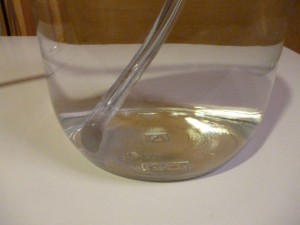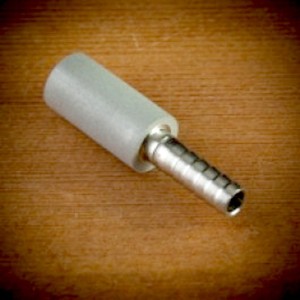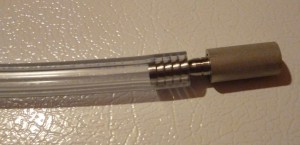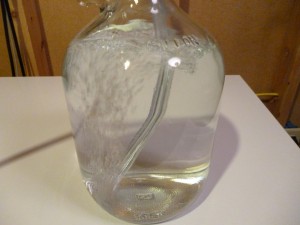
Hands On Review: .5 Micron Oxygenation Stone – Video and Pictures
.5 Micron Diffusion/Carbonating Stone w/ 1/4″ Barb via Amazon
From the product description, check product page for current description, price and availability:
- Stainless steel 0.5 micron diffusion stone with 1/4in barb
- Oxygenate wort thoroughly to insure a healthy fermentation
- Carbonate draft beer quickly
- For use with compressed CO2, O2 or adequately powered air pumps
Possible homebrewing uses include – carbonating, oxygenating and aerating.
This is designed for 1/4″ ID tubing. It fit easily in the tubing, but firmly enough that no tubing clamp is required. I think that’s great because I wasn’t too keen on the idea of trying to sanitize a tubing clamp.

I tried this in a glass jug of water. Here’s the tubing and aeration stone sitting in the jug with no pressure applied.
A video of the Carbonation/Oxygenation in action
Since I’ve started Oxygenating using pure Oxygen, I’ve experience a noticeable decrease in lag time and fermentations seem more vigorous. This stone works well.
Carbonating Stone with 1/4″ Barb, 0.5 micron – affiliate link, note that multiple variations of this product may be available, as such a different version may appear at this link
This post contains affiliate links. We may make a commission when you use our Amazon links. This will never cost you extra. Thank you for supporting Homebrew Finds!
pinned amazonreview:carbaerationstone



What is the most economical regulator to hook to an oxygen tank?
For those that are using this in kegs, do you leave it in or did you make a “carbonation” lid? I just ordered one, but Im not sure if I should just hook it up to the gas port, or if I should find a way to pull out of the keg.
I have one in a lid. I have just left it in the keg before (switching the co2 line to the in port of the keg after carbonated). It works fine this way.
You can just hook it up to the gas port. But that’s not without it’s challenges… Remember the beerstone will be below the liquid level. If you use a T or something in your co2 lines you might ‘suck’ beer into your co2 lines while another low pressure keg is hooked up. My advice if you use it directly on the in line… hook it up in a manor you can remove it when it’s done carbonating (by opening the keg and using a sanitized glove or something)
FYI when you use it in your wort…don’t open it up all the way or you’ll just waste o2. You want just enough o2 going in that yo barely see any disturbance on the surface (this means it’s being absorbed by the wort instead of just filling the headspace above the wort.
Good point. I’m using CO2 for this post.
Same applies if you use co2 to carbonate though… I mean it’s not going to hurt you or anything…but you’re wasting co2.
I use a stone for oxygenation of my wort. I also use one for carbonating my beer in my keg.
Here’s a very inexpensive air pump (~$6) to go along with it…
http://www.amazon.com/Tetra-77851-Whisper-Pump-10-Gallon/dp/B0009YJ4N6
Have you seen any inexpensive air filters to go with this?
I have seen varying reports of people using vs not using a filter. The consensus that I have is that if you are currently shaking your fermenter, you are pulling the same exact air into your beer! So using a pump is doing the exact same thing without all of the manual effort that comes with shaking.
I don’t plan on doing this in a damp smelly room, so I really don’t think I am going to introduce anything into my beer that will not be killed off once the yeast takes off! (which will be quickly since I will be dumping active yeast starters into a well aerated wort)
Feel free to post a link telling me that I am wrong, but I am going to try it for a batch to see how it goes.
When you’re shaking your carboy you have a relatively small volume of air. If you’re running an aquarium pump you’re pushing a much higher volume of air through your beer. So, you’re more likely to pick up something. Maybe it still works fine in most cases. I’m just saying it’s not an apples to apples comparison because of the volumes we’re talking about. My advice is to just pick up an oxygen regulator. You’re getting more oxygen into your beer in a lot less time.